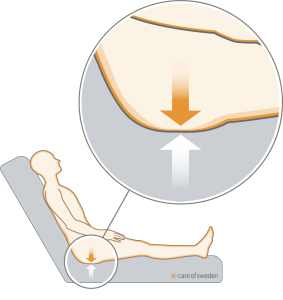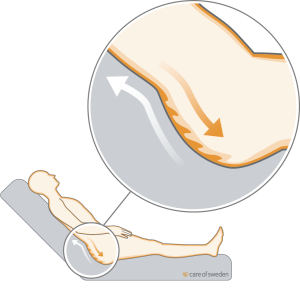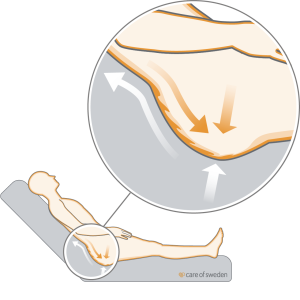
What is a pressure injuries?
“Pressure injuries are a localized injury to the skin and/or underlying tissue, resulting from pressure or pressure in combination with shear. Pressure ulcers typically occur over bony prominences but can also be related to a medical device or other object.”(1)
Pressure
For a pressure ulcer to develop, tissues need to be subjected to pressure. Pressure ulcers can occur when an individual’s body weight is exerted against a surface or through externally applied force, such as the force from medical devices. Pressure ulcers can also arise from a combination of these forces. The amount of pressure required for a pressure ulcer to form depends on both the intensity of the pressure and the duration of tissue exposure to pressure. The sensitivity to pressure varies among individuals and in different tissues. The damage can manifest as intact skin or an open wound. (1)

© Susanna Flodin
© Susanna Flodin
Shear
Shear occurs when the skin and/or underlying layers of tissue are displaced in relation to each other. Shear can occur, for example, when the patient is shifted/slides in bed, when the head end of the bed is raised, or when a foot or elbow rubs against the surface. This can stretch or twist blood vessels, which impairs circulation in the tissue or, in some cases, completely stops circulation.(1)
Pressure & Shear
It is necessary for there to be some form of pressure for a pressure ulcer to develop, which means pressure ulcers do not solely occur due to shear. (1) Pressure in combination with shear can occur, for example, when the bed is raised from a lying to a sitting position, and the patient shifts/slides downward on the surface.
What actually happens at the tissue level when a pressure ulcer develops? Pressure ulcers arise as a result of two primary etiological factors: ischemia and/or cell deformation. (1)
© Susanna Flodin
Ischemia
(low pressure over a long period)
When an area is subjected to sustained pressure, blood circulation in the skin deteriorates. The cells do not receive enough oxygen, resulting in cell death, which in turn leads to the formation of pressure ulcers. This is referred to as ischemia. Cell death due to ischemia is typically a slow process, taking several hours before the cell dies and a wound becomes visible. ⁽²⁾⁽³⁾.
Cell Deformation
(intense pressure over a short period)
Cell deformation arises as a result of pressure. This pressure is intense enough to damage the cell’s cytoskeleton and cause the cell membrane to rupture. The permeability of the cell increases (the cell’s ability to allow substances to pass through), and the cell loses its ability to maintain its central functions. This, in turn, leads to cell death and the development of pressure ulcers. Cell deformation, on the other hand, is a process that can occur very quickly, and pressure ulcers can develop within just a few minutes.⁽²⁾
References
- European Pressure Ulcer Advisory Panel, National Pressure Injury Advisory Panel and Pan Pacific Pressure Injury Alliance. Prevention and Treatment of Pressure Ulcers/Injuries: Clinical Practice Guideline. The international Guideline. Emily Haesler (Ed.). EPUAP/NPIAP/PPPIA: 2019
- Gefen, A., Brienza, D. M., Cuddigan, J., Haesler, E., & Kottner, J. (2022). Our contemporary understanding of the aetiology of pressure ulcers/pressure injuries. International wound journal, 19(3), 692–704. https://doi.org/10.1111/iwj.13667

